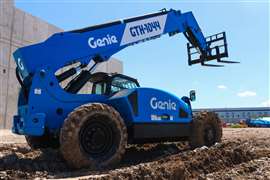Emerging construction technologies
27 December 2022
Rob Smith, CTO of cloud services provider and AEC specialist Creative ITC, discusses some of the latest industry trends and explores the technology solutions emerging to help construction businesses overcome industry challenges.
Digital transformation across the architecture, engineering and construction (AEC) sector has accelerated over recent years as firms harness emerging construction technologies in pursuit of competitive advantage.
 Photo: AdobeStock
Photo: AdobeStock
The pace of change shows no sign of slowing; the global AEC market is predicted to grow at rate of 10.7% CAGR, reaching a value of $15,842 million by 2028.
Technology is driving continuing advances in design, sustainability and health and safety, as firms start to rethink operational and economic models.
Immersive AR and VR experiences are being employed to better convey design intent. Tools like Omniverse are emerging to enable new visual effects and digital twin simulations to make the metaverse 3D-world more tangible.
Purpose-built VDI solutions are enabling remote working at enterprise scale and improving supply chain collaboration, accelerating project delivery.
Robots and drones are being adopted to eliminate risk to humans on site, while AI and machine learning are among the solutions helping to reduce project risks and costs.
Economic models are also being redefined with new, tech-driven construction techniques. 3D-printing is being explored as a route to reduce build costs of new homes.
Investment in construction technology
Continued high levels of IT investment by construction firms compared to other industry verticals are largely a result of the nature of projects and business models across the sector.
Technology has become not just a necessary cost, but an essential route to revenue and a way to unlock greater ROI.
Firms continue to invest in new technologies to facilitate mission critical tools, high data consumption and mobile workforces. Growing data sets and continued app development mean firms must keep optimising data centre infrastructure and devices.
The need for rapid IT spin up for new project teams is another driving force. There’s growing reliance and spend on evolving technologies to ensure the provision of strong user experience and collaboration across complex supply chains.
Further investment is also anticipated to ensure business resilience in the face of increasing cyberthreats.
BIM and datasets
With AEC still a complex team sport, legacy systems and linear processes aren’t helped by specialist industry apps not built for easy integration. Design workflows require massive data import and export routines and colossal image rendering requirements can hamper project delivery.
Growth in file sizes and software requirements has increased dramatically. With BIM models and datasets exploding in size, the consequences of overstretched in-house technical teams are also playing out in this tight-margin environment.
What cyber risks are posed to construction firms?
As businesses become ever-more reliant on technology for mission critical systems, growing cyber risk is increasingly threatening innovation.
Recognising the potential to halt major infrastructure projects and tarnish reputations, cyber criminals are targeting architecture, engineering and construction firms, according to a recent report.
Almost half of UK built environment firms have experienced a ransomware attack in the past two years. The surge in remote working is opening fresh loopholes in this fast-changing threat landscape and cyber criminals are actively exploiting employees as the weak link in corporate defences.
With two in five UK IT teams overwhelmed by security alerts, construction firms are adopting new models of cyber security. Specialist managed service providers (MSP) are emerging, providing Security Operations Centre-as-a-Service (SOCaaS) solutions which make it fast and easy for organisations of any size to deploy world-class security operations that continually guard against attacks in an efficient and sustainable way.
Combining the latest cloud technologies with human expertise, SOCaaS providers complement firms’ in-house IT teams, ensuring rapid, real-time threat responses 24/7 and applying that learning to strengthen their cyber postures and resilience.
Digital transformation risks for the AEC sector
As the marketplace and technology continue to evolve at pace, updating legacy systems is another big issue for the AEC industry. With major construction projects taking years to complete, many firms are left exposed to old software that’s ever harder to scale, integrate, maintain and secure.
Specialist apps may have been developed using ancient code by people no longer with the company, and each app may be separately licenced and hosted from multiple servers and virtual machines.
Specialist providers with in-depth knowledge and experience in the construction sector are developing new solutions to help firms futureproof their IT and facilitate digital transformation.
 Rob Smith, CTO of cloud services provider and AEC specialist Creative ITC
Rob Smith, CTO of cloud services provider and AEC specialist Creative ITC
To help AEC firms overcome challenges faced with modernising IT systems, Creative’s Modern Application Platform (MAP) is designed to de-risk legacy system updates while stretching budgets using advanced Kubernetes and containerisation technologies.
MAP provides organisations with a single-stop solution for updating older software to the very latest languages and frameworks, while carefully arranging and simplifying often scary and costly cloud transitions.
Companies also benefit from a simple consumption model, designed for the AEC sector, reducing costs and modernisation lead times and releasing internal IT resources for impactful strategic innovation projects.
Managing data
Most business data is accessed and stored across multiple solutions, formats and locations around the world.
Rather than data being stored in fixed locations which can be controlled and managed easily, this unstructured data is a mounting industry-wide challenge for the global construction sector.
IT teams are left managing complex data islands and, server sprawl inevitably results, leading to inefficient use of storage resources and poor data recovery times.
Consequently, hybrid workers and virtual teams can’t perform effectively, struggling to access, validate and share data.
Again, new purpose-built AEC solutions are now available to help tackle these issues. Cloud File Services provides construction firms with a more consolidated, centralised and secure storage environment utilising local file caching.
Data retrieval speeds are dramatically increased by reducing reliance on the underlying slower storage layer. Active data is served up much faster to users than is possible by accessing the primary storage location.
They’re also less likely to be slowed down by issues that often arise from unstructured data, such as duplicate file versions and document corruption or loss.
Accelerating innovation in construction
As digital transformation gathers pace across all industry sectors, there’s mounting pressure to make IT simpler to manage and less costly to own and operate.
AEC firms are increasingly seeing the role of Infrastructure-as-a-Service models for elements like storage, networking and compute – and how they can be applied to stretch IT budgets and resources to accelerate innovation.
In an industry playing revenue catch-up post-Covid, savings on infrastructure, data centre space, licensing, support and headcount also offer a welcome balance sheet boost.
In the transition towards Everything as a Service (XaaS) IT models to boost business agility and efficiency, construction firms must tread a careful path to ensure solutions not only align with future needs but also dovetail seamlessly with existing IT systems.
Digital transformation journeys are growing ever-more complex and difficult to navigate. Hot on the heels of infrastructure virtualisation, application virtualisation is now snowballing.
Yet compute and storage – and therefore virtualisation – are coming ever closer to the edge. This increases the need for greater workload mobility, automated operations, and improved performance and availability of resources.
Construction firms are increasingly recognizing the value of MSPs with a successful track record in the sector, who are focused on developing solutions to help them to overcome the unique set of industry and technology obstacles.
Emerging, purpose-built technologies from this new breed of AEC sector specialists will be invaluable in accelerating innovation across the sector to help businesses stay ahead of the curve.
STAY CONNECTED


Receive the information you need when you need it through our world-leading magazines, newsletters and daily briefings.
CONNECT WITH THE TEAM











